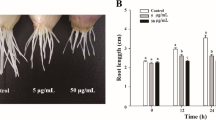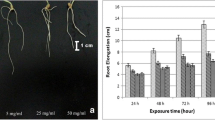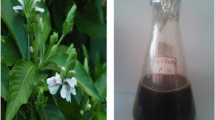Abstract
The commercial usage of Al2O3 nanoparticles (Al2O3 NPs) has gone up significantly in the recent times, enhancing the risk of environmental contamination with these agents and their consequent adverse effects on living systems. The current study has been designed to evaluate the cytogenetic potential of Al2O3 NPs in Allium cepa (root tip cells) at a range of exposure concentrations (0.01, 0.1, 1, 10, and 100 μg/mL), their uptake/internalization profile, and the oxidative stress generated. We noted a dose-dependent decrease in the mitotic index (42 to 28 %) and an increase in the number of chromosomal aberrations. Various chromosomal aberrations, e.g. sticky, multipolar and laggard chromosomes, chromosomal breaks, and the formation of binucleate cells, were observed by optical, fluorescence, and confocal laser scanning microscopy. FT-IR analysis demonstrated the surface chemical interaction between the nanoparticles and root tip cells. The biouptake of Al2O3 in particulate form led to reactive oxygen species generation, which in turn probably contributed to the induction of chromosomal aberrations.



Similar content being viewed by others
References
Anane R, Creppy EE (2001) Lipid peroxidation as pathway of aluminium cytotoxicity in human skin fibroblast cultures: prevention by superoxide dismutase catalase and vitamins E and C. Hum Exp Toxicol 20:477–481
Arruebo M, Valladares M, González-Fernández Á (2009) Antibody-conjugated nanoparticles for biomedical applications. J Nanomater 2009:1–24
Asztemborska M, Steborowski R, Kowalska J, Bystrzejewska-Piotrowska G (2015) Accumulation of Aluminium by Plants Exposed to Nano-and Microsized Particles of Al. Int J Environ Res 9(1):109–116
Bakare AA, Mosuro AA, Osibanjo O (2000) Effect of simulated leachate on chromosomes and mitosis in roots of Allium cepa (L). J Environ Biol 21(3):263–271
Baker TJ, Tyler CR, Galloway TS (2014) Impacts of metal and metal oxide nanoparticles on marine organisms. Environ Pollut 186:257–271
Banasik A, Lankoff A, Piskulak A, Adamowska K, Lisowska H, Wojcik A (2005) Aluminium-induced micronuclei and apoptosis in human peripheral blood lymphocytes treated during different phases of the cell cycle. Environ Toxicol 20:402–406
Cabrera GL, Rodriguez DMG (1999) Genotoxicity of soil from farmland irrigated with wastewater using three plant bioassays. Mutat Res Fundam Mol Mech 426(2):211–214
Chen L, Yokel RA, Hennig B, Toborek M (2008) Manufactured aluminum oxide nanoparticles decrease expression of tight junction proteins in brain vasculature. J Neuroimmune Pharmacol 3(4):286–295
Chen R, Ratnikova TA, Stone MB, Lin S, Lard M, Huang G, Hudson JS, Ke PC (2010) Differential uptake of carbon nanoparticles by plant and mammalian cells. Small 6(5):612–617
Darlington CD, Mc Leish L (1951) Action of maleic hydrazide on the cell. Nature 167:407–408
Darlington TK, Neigh AM, Spencer MT, Nguyen OT, Oldenburg SJ (2009) Nanoparticle characteristics affecting environmental fate and transport through soil. J Environ Toxicol Chem 28(6):1191–1199
Di Virgilio AL, Reigosa M, Arnal PM, Lorenzo F, de Mele M (2010) Comparative study of the cytotoxic and genotoxic effects of titanium oxide and aluminium oxide nanoparticles in Chinese hamster ovary (CHO-K1) cells. J Hazard Mater 177(1):711–718
Donaldson K, Stone V, Clouter A, Renwick L, MacNee W (2001) Ultrafine particles. Occup Environ Med 58(3):211–216
Faraji AH, Wipf P (2009) Nanoparticles in cellular drug delivery. Bioorg Med Chem 17(8):2950–2962
Firbas P, Amon T (2013) Allium Chromosome Aberration Test for Evaluation Effect of Cleaning Municipal Water with Constructed Wetland (CW) in Sveti Tomaž, Slovenia. J Bioremed Biodegrad 4(4):189–193
Fiskesjo G (1985) The Allium test as a standard in environmental monitoring. Hereditas 102:99–112
Fiskesjo G (1997) Allium test for screening chemicals; evaluation of cytological parameters. In: Wuncheng W, Gorsuch JW, Hughes JS (eds) Plants for environmental studies. CRC Lewis Publishers, Boca Raton, pp 307–333
Future Markets Inc. (2013) The global market for metal oxide nanoparticles to 2020, 322. Available: http://www.researchandmarkets.com/research/jkjd5k/the_global_market
Ghodake G, Seo YD, Lee DS (2011) Hazardous phytotoxic nature of cobalt and zinc oxide nanoparticles assessed using Allium cepa. J Hazard Mater 186(1):952–955
Grant WF (1982) Chromosome aberration assays in Allium: A report of the US Environmental Protection Agency gene-tox program. Mutat Res Rev Genet 99(3):273–291
Hasenstein KH, Evans ML (1988) Effects of cations on hormone transport in primary roots of Zea mays. Plant Physiol 86(3):890–894
Illéš P, Schlicht M, Pavlovkin J, Lichtscheidl I, Baluška F, Ovečka M (2006) Aluminium toxicity in plants: internalization of aluminium into cells of the transition zone in Arabidopsis root apices related to changes in plasma membrane potential, endosomal behaviour, and nitric oxide production. J Exp Bot 57(15):4201–4213
Jiang J, Oberdörster G, Biswas P (2009) Characterization of size, surface chargeagglomeration state of nanoparticle dispersion for toxicological studies. J Nanoparticle Res 11:77–89
Kanaya N, Gill BS, Grover IS, Murin A, Osiecka R, Sandhu SS, Andersson HC (1994) Vicia faba chromosomal aberration assay. Mutat Res Fundam Mol Mech 310(2):231–247
Kim YJ, Choi HS, Song MK, Youk DY, Kim JH, Ryu JC (2009) Genotoxicity of aluminum oxide (Al2O3) nanoparticle in mammalian cell lines. Mol Cell Toxicol 5(2):172–178
Kristen U (1997) Use of higher plants as screens for toxicity assessment. Toxicol in Vitro 11(1):181–191
Kumari M, Mukherjee A, Chandrasekaran N (2009) Genotoxicity of silver nanoparticles in Allium cepa. Sci Total Environ 407(19):5243–5246
Kumari M, Khan SS, Pakrashi S, Mukherjee A, Chandrasekaran N (2011) Cytogenetic and genotoxic effects of zinc oxide nanoparticles on root cells of Allium cepa. J Hazard Mater 190(1):613–621
Liman R (2013) Genotoxic effects of Bismuth (III) oxide nanoparticles by Allium and Comet assay. Chemosphere 93(2):269–273
Lu X, Rasco B (2012) Determination of Antioxidant Content and Antioxidant Activity in Foods using Infrared Spectroscopy and Chemometrics: A Review. Crit Rev Food Sci Nutr 52(10):853–875
Lu X, Rasco BA, Jabal JM, Aston DE, Lin M, Konkel ME (2011) Investigating antibacterial effects of garlic (Allium sativum) concentrate and garlic-derived organosulfur compounds on Campylobacter jejuni by using Fourier transform infrared spectroscopy, Raman spectroscopy, and electron microscopy. Appl Environ Microbiol 77(15):5257–5269
Maquelin K, Kirschner C, Choo-Smith LP, Van Den Braak N, Endtz HP, Naumann D, Puppels GJ (2002) Identification of medically relevant microorganisms by vibrational spectroscopy. J Microbiol Methods 51:255–271
Mederios MDC, Takahashi CS (1987) Effects of Luffa operculata on Allium cepa root tips cell. Cytologia 52:255–259
Mohandas T, Grant WF (1972) Cytogenetic effect of 2, 4-D and amitol in relation to nuclear volume DNA content in some higher plants. Can J Genet Cytol 14:773–783
Movasaghi Z, Rehman S, Rehman IU (2008) Fourier transform infrared (FTIR) spectroscopy of biological tissues. Appl Spectrosc Rev 43:134–179
Mukherjee A, Mohammed Sadiq I, Prathna TC, Chandrasekaran N (2011) Antimicrobial activity of aluminium oxide nanoparticles for potential clinical applications. In: Méndez-Vilas A (ed) Science against microbial pathogens: communicating current research and technological advances. Spain. vol. 1, pp 245–251
Pakrashi S, Dalai S, Prathna TC, Trivedi S, Myneni R, Raichur AM, Chandrasekaran N, Mukherjee A (2013) Cytotoxicity of aluminium oxide nanoparticles towards fresh water algal isolate at low exposure concentrations. Aquat Toxicol 132:34–45
Pakrashi S, Jain N, Dalai S, Jayakumar J, Chandrasekaran PT, Raichur AM, Chandrasekaran N, Mukherjee A (2014) In Vivo Genotoxicity Assessment of Titanium Dioxide Nanoparticles by Allium cepa Root Tip Assay at High Exposure Concentrations. PLoS One 9(2):e87789
Panda KK, Achary VMM, Krishnaveni R, Padhi BK, Sarangi SN, Sahu SN, Panda BB (2011) In vitro biosynthesis and genotoxicity bioassay of silver nanoparticles using plants. Toxicol in Vitro 25(5):1097–1105
Prabhakar PV, Reddy UA, Singh SP, Balasubramanyam A, Rahman MF, Indu Kumari S, Agawane SB, Murty USN, Grover P, Mahboob M (2012) Oxidative stress induced by aluminium oxide nanomaterials after acute oral treatment in Wistar rats. J Appl Toxicol 32:436–445
Rao KSJ, Stein R (2003) First evidence on induced topological changes in supercoiled DNA by an aluminium Daspartate complex. J Biol Inorg Chem 8:823–830
Rico CM, Majumdar S, Duarte-Gardea M, Peralta-Videa JR, Gardea-Torresdey JL (2011) Interaction of nanoparticles with edible plants and their possible implications in the food chain. J Agric Food Chem 59(8):3485–3498
Ryan PR, Ditomaso JM, Kochian LV (1993) Aluminium toxicity in roots: an investigation of spatial sensitivity and the role of the root cap. J Exp Bot 44(2):437–446
Sadiq IM, Pakrashi S, Chandrasekaran N, Mukherjee A (2011) Studies on toxicity of aluminum oxide (Al2O3) nanoparticles to microalgae species: Scenedesmus sp. and Chlorella sp. J Nanoparticle Res 13(8):3287–3299
Satapathy R, Swamy P (2013) Preparative isolation of flavonoids from wattakaka volubilis (linn. f.) leaf extracts and its role as antimitotic and antiproliferating agent. Int J Pharm Biol Sci 4(3):454–460
Sayes CM, Warheit DB (2009) Characterization of nanomaterials for toxicity assessment. Wiley Interdiscip Rev Nanomed Nanobiotechnol 1(6):660–670
Schrand AM, Rahman MF, Hussain SM, Schlager JJ, Smith DA, Syed AF (2010) Metal-based nanoparticles and their toxicity assessment. J Nanomed Nanobiotechnol 2:544–568
Tang D, Shi S, Li D, Hu C, Liu Y (2007) Physiological and biochemical responses of Scytonema javanicum (cyanobacterium) to salt stress. J Arid Environ 71(3):312–320
Tsaousi A, Jones E, Case CP (2010) The in vitro genotoxicity of orthopaedic ceramic (Al2O3) and metal (CoCr alloy) particles. Mutat Res Genet Toxicol Environ 697(1):1–9
World Health Organization (1985) Guide to short-term tests for detecting mutagenic and carcinogenic chemicals. Environmental Health Criteria 51. WHO, Geneva, p 107
Yang ST, Wang T, Dong E, Chen XX, Xiang K, Liu JH, Liu YF, Wang H (2012) Bioavailability and preliminary toxicity evaluations of alumina nanoparticles in vivo after oral exposure. Toxicol Res 1(1):69–74
Acknowledgments
We would like to thank the Sophisticated Analytical Instrument Facility (SAIF) at Indian Institute of Technology, Madras for the ICP-OES analysis facility and Indian Institute of Sciences, Bangalore for the Confocal Laser microscopy facility.
Compliance with Ethical Standards
There were no human participants nor animals involved in this study.
Conflict of interest
The authors declare that they have no conflict of interests.
Author information
Authors and Affiliations
Corresponding author
Additional information
Responsible editor: Elena Maestri
Dr. Amitava Mukherjee, Sr. Professor & Deputy Director, Centre for Nanobiotechnology, VIT University, and holds a BE, ME, Ph.D.
Rights and permissions
About this article
Cite this article
Rajeshwari, A., Kavitha, S., Alex, S.A. et al. Cytotoxicity of aluminum oxide nanoparticles on Allium cepa root tip—effects of oxidative stress generation and biouptake. Environ Sci Pollut Res 22, 11057–11066 (2015). https://doi.org/10.1007/s11356-015-4355-4
Received:
Accepted:
Published:
Issue Date:
DOI: https://doi.org/10.1007/s11356-015-4355-4




